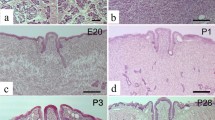Summary
Lectins were used as probes to investigate the mechanism of embryonic induction. Concanavalin (Con A) and gorse agglutinin out of 7 species of lectins tested were found to have strong neural-inducing effect on the presumptive ectoderm of newt gastrulae. Their effects were abolished by the addition of α-methyl-D-mannoside and α-L-fucose, respectively. Succinyl-Con A had a weak inducing activity in comparison to Con A. Autoradiography of3H-Con A-treated explants revealed that Con A bound to the inner surface, but not to the outer surface of ectoderm and was successively incorporated into cytoplasm.3H-Thymidine incorporation was lower in the first half and higher in the second half of the 60 h cultivation period in Con A-treated explants as compared to controls.
Con A-Sepharose had a strong inductive effect. This suggests that neural induction is caused through Con A binding to the plasma membrane, but not through incorporation into the cytoplasm of the ectoderm cells.
Similar content being viewed by others
References
Burton K (1956) A study of the condition and mechanism of the diphenylamine reaction for the colorimetric estimation of deoxyribonucleic acid. Biochem J 95:315–322
Croft DN, Lubran M (1965) The estimation of deoxyribonucleic acid in the presence of sialic acid: application to analysis of human gastric washings. Biochem J 95:612–620
Edelson PJ, Cohn ZA (1974a) Effects of concanavalin A on mouse peritoneal macrophages. I. Stimulation of endocytic activity and inhibition of phago-lysosome formation. J Exp Med 140:1364–1386
Edelson PJ, Cohn ZA (1974b) Effects of concanavalin A on mouse peritoneal macrophages. II. Metabolism of endocytized proteins and reversibility of the effects by mannose. J Exp Med 140:1387–1403
Goldman R, Raz A (1975) Concanavalin A and the in vitro induction in macrophages of vacuolation and lysosomal enzyme synthesis. Exp Cell Res 96:393–405
Goldman R, Sharon N, Lotan R (1976) A differential response elicited macrophages on interaction with lectins. Exp Cell Res 99:408–422
Gunther GR, Wang JL, Yahara I, Cunningham BA, Edelman GM (1973) Concanavalin A derivatives with altered biological activities. Proc Natl Acad Sci USA 70:1012–1016
Holtfreter J (1933) Nachweis der Inductionsfähigkeit abgetöteter Keimteile. Isolations- und Transplantationsversuche. Wilhelm Roux's Archives 128:584–633
Imoh H, Sasaki N, Kawakami I, Hayashi H (1976) Changes in macromolecular synthesis inTriturus presumptive epidermis stimulated by inducing agent. J Exp Zool 182:31–40
Johnson KE, Smith EP (1976) The binding of concanavalin A to dissociated embryonic amphibian cells. Exp Cell Res 101:63–70
Kawakami I, Oseko H (1978) Inductive effect of Con A on presumptive ectoderm of newt gastrula (in Japanese) Zool Mag 87:363
Kawakami I, Oseko H (1979) Response of presumptive ectoderm of newt gastrula to Con A (in Japanese). Zool Mag 88:457
Lamon JP, Duprat AM (1976) Effects de la concanavalin A sur la morphologie et le comportement de cellules embryonnaires d'Urodèles en différenciation in vitro. Experientia 32:1568–1572
Monroy A, Ortolani G, O'Dell D, Millonig G (1973) Binding of concanavalin A to the surface of unfertilized and fertilized ascidian eggs. Nature 242:409–410
Moran D (1974a) The inhibitory effects of concanavalin A on the development of the amphibian embryo. J Exp Zool 188:361–365
Moran D (1974b) The action of concanavalin A on migrating and differentiating neural crest cells. Exp Cell Res 86:365–373
Neri A, Roberson MM, Connally DT, Oppenheimer SB (1975) Quantative evaluation of concanavalin A receptor site distributions on the surfaces of specific population of embryonic cells. Nature 258:342–344
Nicolson GL (1974) The interactions of lectins with animal cell surface. Int Rev Cytol 39:133–140
Nosek J (1978) Changes in the cell surface coat during development ofXenops laevis embryos, detected by lectins. Wilhelm Roux's Archives 184:181–193
O'Dell DS, Tencer R, Monroy A, Brachet J (1974a) The pattern of Concanavalin A-binding sites during the early development ofXenops laevis. Cell Differ 3:193–198
O'Dell DS, Ortolani G, Monroy A (1974b) Increased binding of radioactive Concanavalin A during maturation ofAscidia eggs. Exp Cell Res 83:408–411
Okada Yo K, Ichikawa M (1947) Normal table ofTriturus pyrrhogaster. Jpn J Exp Morphol 3:1–6
Osawa T, Mori R (1976) Lectins (in Japanese). Kodan-sha Scientific, Japan
Petty HR, Ware BR (1979) Macrophage response to concanavalin A: Effect of surface crosslinking on the electrophoretic mobility distribution. Proc. Natl. Acad Sci USA 76:2278–2282
Roberson MM, Armstrong PB (1979) Regional segreation of Con A receptors on dissociated amphibian embryo cells. Exp Cell Res 122:23–29
Roberson MM, Neri A, Oppenheimer SB (1975) Distribution of concanavalin A receptor sites on specific populations of embryonic cells. Science 189:639–640
Roberson MM, Oppenheimer SB (1975) Quantative agglutination of specific population of sea urchin embryo with concanavalin A. Exp Cell Res 91:263–268
Suzuki A, Kuwabara Y, Kuwana T (1976) Analysis of cell proliferation during early embryogenesis. Dev Growth Differ 18:447–455
Takahashi Y, Asao T (1974) Study of the nuclei isolated from newt embryo by the use of Ficoll. Dev Growth Differ 16:281–285
Takata K (1978) Mesodermalization of presumptive ectodermal cells (in Japanese). Zool Mag 87:363
Takata K, Ozawa R (1979) Effect of lectins on inductive differentiation of the presumptive ectoderm cells (in Japanese). Zool Mag 88:457
Tiedemann HI, Born J (1978) Biological activity of vegetalizing and neuralizing inducing factors after binding to BAC-cellulose and CNBr-Sepharose. Wilhelm Roux's Archives 184:285–299
Yasaka T, Kambara T (1978) Effect of concanavalin A and its succinylated derivative on the oxidative metabolism of guinea pig peritoneal macrophages. Biochem Biophys Acta 508:306–312
Author information
Authors and Affiliations
Rights and permissions
About this article
Cite this article
Takata, K., Yamamoto, K.Y. & Ozawa, R. Use of lectins as probes for analyzing embryonic induction. Wilhelm Roux' Archiv 190, 92–96 (1981). https://doi.org/10.1007/BF00848401
Received:
Accepted:
Issue Date:
DOI: https://doi.org/10.1007/BF00848401




